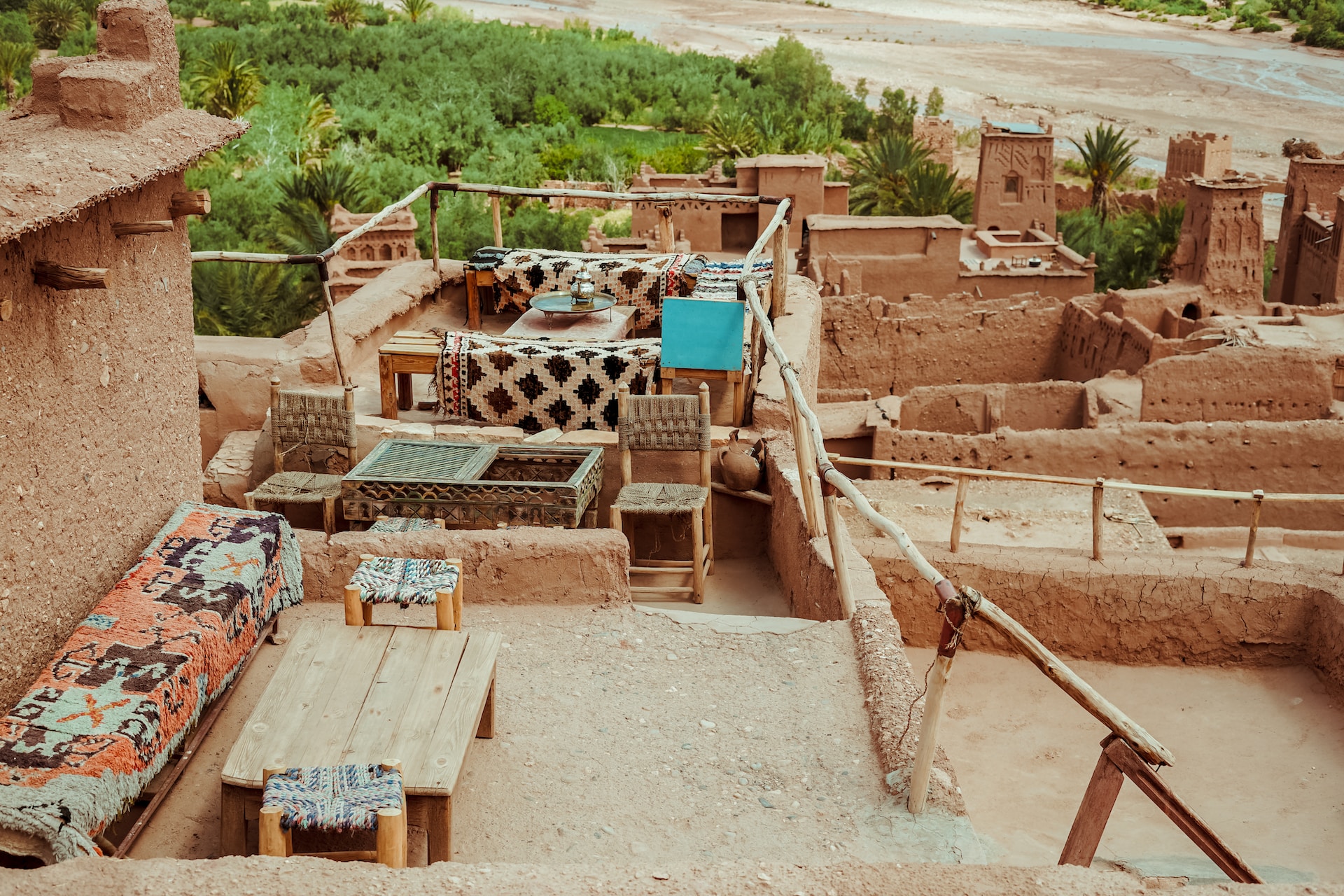Off The Grid
Mud Brick Houses: Building Sustainable Homes from Earth

As the world turns its attention towards sustainable living, it’s time we rediscovered one of humanity’s oldest building materials: mud. This humble substance, underfoot and often overlooked, has been providing us with shelter for thousands of years. Today, in the spirit of self-reliance and respect for the environment, we’re going to delve into the art and science of building mud brick houses.
Mud brick, also known as adobe, is an incredibly versatile and environmentally friendly building material. It’s made from a mixture of earth, water, and usually some form of fibrous or organic material such as straw or dung. This combination is then shaped into bricks and dried in the sun. The result is a sturdy, cost-effective, and sustainable building material that’s been used in construction across cultures and continents.
Building a mud brick house isn’t just about going back to basics; it’s about harnessing the earth’s natural resources in a sustainable way. The materials are readily available and require little energy to produce, making mud brick an excellent choice for the environmentally conscious. Moreover, mud brick houses have excellent thermal properties, keeping you cool in the summer and warm in the winter.
Now, let’s get down to the nitty-gritty of building with mud bricks. The first step is to find the right soil. A good mix for mud bricks is typically around 70% sand and 30% clay. This ratio might vary depending on your local soil composition, so it’s a good idea to do some tests before diving into construction.
Next, you’ll need to prepare your bricks. Mix your soil with water until it reaches a moldable consistency. Add your fibrous material, such as straw, to help bind the mixture together and prevent cracking during the drying process. Once your mixture is ready, pack it tightly into your brick molds.
Drying is a critical part of the process. It’s best to dry your bricks slowly to prevent cracking. This can take anywhere from a few days to several weeks, depending on your climate. Once your bricks are dry, they’re ready to be used.
Building with mud bricks is a bit different than working with conventional materials. The bricks are laid with a mud mortar, and the walls are usually thicker than those of a standard house. This requires careful planning and design, but the result is a sturdy and durable structure.
One important aspect to consider when building with mud bricks is maintenance. While mud brick houses are durable, they do require regular maintenance to keep them in good condition. This usually involves applying a fresh coat of mud plaster to the exterior walls to protect them from the elements.
Building a mud brick house is a labor-intensive process, but the rewards are worth it. Not only will you have a sustainable and cost-effective home, but you’ll also have the satisfaction of knowing that you’ve built it with your own two hands.
Remember, building with mud bricks isn’t just a construction method; it’s a philosophy. It’s about understanding and respecting the materials that the earth provides, and using them in a way that minimizes our impact on the environment.
So, whether you’re planning to build a mud brick house or just curious about alternative building methods, I hope this guide has given you some food for thought. Building with mud bricks might not be for everyone, but for those willing to get their hands dirty, it’s a rewarding and sustainable choice.
In the wild, you learn to use what nature provides, and there’s no greater provider than the earth beneath our feet. Building with mud bricks is a testament to the resilience and resourcefulness of the human spirit, a trait that every survivalist holds dear. So, here’s to mud, to sustainability, and to the enduring strength of the human spirit.

Off The Grid
Turning Trash into Treasure: Can You Upcycle Off-the-Grid?

Upcycling is a sustainable practice that involves repurposing discarded materials into useful items, giving them a new lease on life. This eco-friendly approach can be particularly valuable for those who live off the grid or enjoy spending time in the great outdoors. By turning waste into practical tools, you not only reduce your environmental impact but also enhance your self-sufficiency and resourcefulness. In this article, we will explore several upcycling ideas that can help you create valuable off-the-grid tools from seemingly useless items.
One idea is to create a plastic bottle fish trap. Fishing is a popular activity for many outdoor enthusiasts, and a fish trap can help increase your chances of catching dinner. To make a simple fish trap, cut the top off a large plastic bottle and invert it, placing it back into the body of the bottle. Secure the two parts together with duct tape or string, and poke small holes around the bottle for water to flow through. Add some bait, such as bread or worms, and submerge the trap in a water body. The fish will swim in through the inverted opening but will have difficulty finding their way out.
Another idea is to create a tin can lantern. A lantern is an essential tool for any off-the-grid adventure, providing much-needed light during the night. To create a tin can lantern, simply clean an empty tin can and remove the label. Using a hammer and nail, punch a series of holes in a pattern of your choice around the can. Attach a wire handle to the top, and place a candle or tea light inside. The holes will cast a beautiful pattern of light, creating a functional and decorative lantern.
A glass bottle greenhouse is a valuable addition to any off-the-grid homestead, allowing you to extend your growing season and protect your plants from harsh weather. To build a glass bottle greenhouse, collect a large number of glass bottles and remove the labels. Lay a foundation for your greenhouse using bricks or other sturdy materials. Then, start stacking the bottles on their sides, using mortar or clay to hold them together. The glass bottles will create an insulated and light-filled environment, perfect for nurturing your plants.
Composting is an essential practice for sustainable living, turning organic waste into nutrient-rich soil. To create a pallet compost bin, source four wooden pallets and stand them up to create a square enclosure. Secure the corners with screws or metal brackets, and line the inside with chicken wire or mesh to contain the compost. Add your kitchen scraps, yard waste, and other organic materials, turning the pile regularly to speed up the decomposition process.
Cooking is a significant part of off-the-grid living, and having your pots and pans organized and easily accessible is crucial. To create a bicycle wheel pot rack, remove the tire and inner tube from an old bicycle wheel. Hang the wheel from the ceiling using chains or rope, and attach S-hooks around the rim. Hang your pots and pans from the hooks, creating a unique and functional pot rack.
By upcycling waste materials into useful off-the-grid tools, you not only contribute to a more sustainable lifestyle but also develop valuable skills and resourcefulness. These projects are just the beginning; with a little creativity and ingenuity, the possibilities for turning waste into practical tools are endless.
Off The Grid
Off-the-Grid Power: Guide to Harnessing Hand-Crank Devices

Electricity is a crucial part of modern life, powering our homes, gadgets, and appliances. However, access to electricity can be limited or non-existent during emergencies or outdoor adventures. This is where hand-crank devices come in. These portable, manually operated tools generate electricity, allowing you to power your essential devices and equipment when you need it most.
Hand-crank devices work by converting mechanical energy into electrical energy. When you turn the handle, gears inside the device spin a small generator, producing electricity. This simple yet effective technology has been around for decades and is still relevant today, especially for survivalists and outdoor enthusiasts.
There are various types of hand-crank devices available, each designed to serve a specific purpose. Hand-crank flashlights, for example, are an indispensable tool for any survival kit or camping trip. These flashlights generate power through a built-in dynamo, which charges an internal battery or capacitor. A few minutes of cranking can provide hours of light, making them an excellent alternative to traditional battery-powered flashlights.
Hand-crank radios are also essential during emergencies or outdoor adventures. They allow you to stay informed about weather updates, emergency broadcasts, and even provide entertainment. Most hand-crank radios come with AM/FM and NOAA weather bands, ensuring you receive vital information when you need it. Some models also include shortwave bands, allowing you to connect with stations worldwide.
Our smartphones have become an essential part of our lives, providing communication, navigation, and access to vital information. In emergency situations or during outdoor adventures, keeping your phone charged can be a challenge. A hand-crank phone charger can generate enough power to make emergency calls or send messages, ensuring you stay connected when it matters the most.
Hand-crank power banks are versatile devices that can charge multiple gadgets, including smartphones, tablets, and GPS devices. They usually come with built-in batteries that can be charged using the hand-crank, solar panels, or even by plugging into a wall socket. This makes them an excellent addition to your survival kit or camping gear, ensuring you have access to power when you need it.
Clean drinking water is essential for survival, and hand-crank water purifiers can help you achieve that. These devices use a combination of mechanical filtration and UV light to remove contaminants and kill harmful microorganisms, providing you with safe drinking water.
When choosing a hand-crank device, consider factors such as durability, power output, and ease of use. Look for devices made from high-quality materials, as they are more likely to withstand harsh conditions and last longer. Additionally, consider the device’s power output, as this will determine how quickly you can charge your gadgets or how long the device will provide light or radio reception.
Incorporating hand-crank devices into your survival kit or outdoor gear can make a significant difference in emergency situations or when you’re off the grid. These devices provide a reliable and sustainable source of electricity, ensuring you have access to essential power when you need it most. By understanding the various types of hand-crank devices available and selecting the right ones for your needs, you can be better prepared for any situation that may arise.
Off The Grid
A Gardener’s Secret: Supercharge Your Garden’s Productivity

Maximizing your garden yield is a crucial goal for any gardener, whether you’re growing your own food for self-sufficiency or simply enjoying the process of nurturing plants. One of the most effective ways to achieve this goal is through companion planting. This age-old technique involves strategically placing different plant species near each other to create a symbiotic relationship that benefits all parties involved. In this article, we’ll explore the benefits of companion planting and offer tips on how to effectively implement this gardening method.
Companion planting offers several advantages for your garden. Some of the key benefits include pest control, improved nutrient uptake, enhanced pollination, space efficiency, and disease prevention.
Pest control is a significant advantage of companion planting. Certain plants naturally repel pests, reducing the need for chemical pesticides. For example, marigolds emit a strong scent that deters pests like aphids and tomato hornworms, making them excellent companions for tomatoes and other plants susceptible to these insects.
Improved nutrient uptake is another benefit of companion planting. Some plants can help their neighbors access nutrients more efficiently. For instance, legumes like beans and peas fix nitrogen in the soil, making it available for other plants to use. Planting these nitrogen-fixers near heavy feeders like tomatoes or corn can improve overall plant health and yield.
Enhanced pollination is also a significant advantage of companion planting. Planting flowers that attract pollinators like bees and butterflies can boost the pollination rates of your fruit and vegetable plants. This increased pollination can result in higher yields and better-tasting produce.
Space efficiency is another benefit of companion planting. By planting different species close together, you can make the most of your available garden space. This is particularly useful for those with limited room to grow, such as urban gardeners or those with small yards.
Disease prevention is also an advantage of companion planting. Some plants release chemicals that can suppress diseases in their neighbors. For example, garlic and onions can help prevent fungal diseases in nearby plants, while certain herbs like basil can repel harmful insects that spread disease.
To maximize the benefits of companion planting, consider the following tips. First, research plant relationships before implementing companion planting. Not all plants make good companions. Some plants can inhibit the growth of their neighbors or attract pests. Therefore, it is essential to research which plants work well together and which should be kept apart.
Second, choose compatible plants when selecting plants for your garden. Consider their growth habits, nutrient requirements, and pest resistance. This will help ensure that your chosen companions will support each other and create a harmonious garden ecosystem.
Third, plan your garden layout. Create a garden plan that takes into account the spatial needs of your plants and their companions. Be sure to leave enough space for each plant to grow and spread out, while still placing them close enough to benefit from their neighbors.
Fourth, rotate crops to prevent the buildup of pests and diseases in the soil. This means planting different plant families in different areas of your garden each season. For example, if you planted tomatoes in one bed this year, plant a different family like legumes or brassicas in that bed next year.
Finally, observe and adapt. As with any gardening technique, companion planting requires observation and adaptation. Monitor your garden closely to see which plant combinations are working well and which may need to be adjusted. Be prepared to modify your garden plan as needed to ensure the best possible yield.
By implementing companion planting in your garden, you can create a thriving ecosystem that benefits all of your plants. This technique not only maximizes your garden’s yield but also contributes to a healthier, more sustainable gardening practice. With careful planning and attention to the needs of your plants, companion planting can transform your garden into a productive and vibrant space.
-

 Preparedness4 months ago
Preparedness4 months agoEx-Ballerina’s Guilty Verdict Sends Tremors Through Gun-Owner Community
-

 Tactical7 months ago
Tactical7 months ago70-Year-Old Fends Off Intruder with Lead-Powered Message
-

 Tactical7 months ago
Tactical7 months agoVape Shop Employee Confronts Armed Crooks, Sends Them Running
-

 Preparedness2 months ago
Preparedness2 months agoGood Samaritan Saves Trooper in Harrowing Interstate Confrontation
-

 Survival Stories1 year ago
Survival Stories1 year agoEmily’s 30-Day Experience of Being Stranded on a Desert Island
-

 Tactical7 months ago
Tactical7 months agoMidnight SUV Theft Interrupted by Armed Homeowner’s Retaliation
-

 Preparedness2 months ago
Preparedness2 months agoArizona Engineer’s Headless Body Found in Desert: Friend Charged
-

 Preparedness2 months ago
Preparedness2 months agoBoy Saves Dad from Bear Attack with One Perfect Shot